Ejector for a pumping station: operating principle, device, installation rules
The deep occurrence of an aquifer is a common problem that is familiar to many land owners. Conventional surface pumping equipment either cannot supply the house with water at all, or feeds it into the system too slowly and with a low pressure.
This problem requires a speedy resolution. Agree, buying a new pump is an expensive and not always financially justified undertaking. The solution to this situation may be an ejector for a water pumping station.
We will tell you how to choose a suitable unit and install it without the help of specialists. And also give step-by-step instruction on the manufacture and connection of a homemade ejector. All stages of the work are accompanied by visual photographs.
The content of the article:
The principle of operation of the ejector
The deeper the water is, the more difficult it is to raise it to the surface. In practice, if the well’s depth is more than seven meters, surface pump copes with its tasks with difficulty.
Of course, for very deep wells it is more appropriate to purchase a high-performance submersible pump. But with the help of an ejector, it is possible to improve the characteristics of a surface pump to an acceptable level and with significantly lower costs.
Ejector - the device is small, but very effective. This unit has a relatively simple design, it can even be made independently from improvised materials. The principle of operation is based on giving the water stream an additional acceleration, which will increase the amount of water coming from the source per unit time.
This solution is especially convenient for those who are going to install or have already installed pumping station with surface pump. The ejector will increase the depth of water intake to 20-40 meters.
It should also be noted that the acquisition of more powerful pumping equipment will lead to a noticeable increase in energy consumption. In this sense, the ejector will bring noticeable benefits.
The ejector for a surface pump consists of the following elements:
- suction chamber;
- mixing unit;
- diffuser;
- narrowed nozzle.
The operation of the device is based on the Bernoulli principle. It states that if the speed of the flow increases, an area with low pressure is created around it. Thus, a rarefaction effect is achieved. Water enters through a nozzle whose diameter is smaller than the size of the rest of the structure.
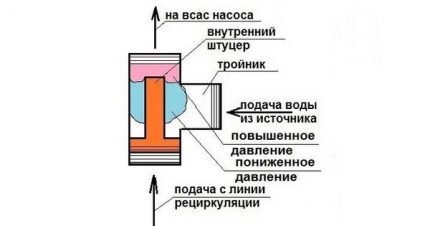
A slight narrowing gives the flow of water a noticeable acceleration. Water enters the mixer chamber, creating an area with reduced pressure inside it. Under the influence of this process, a stream of water under a higher pressure enters the mixer through the suction chamber.
Water does not come into the ejector from wellsbut from the pump. Those. the ejector must be installed so that part of the water raised by the pump returns to the ejector through the nozzle. The kinetic energy of this accelerated flow will be continuously transmitted to the mass of water that is absorbed from the source.
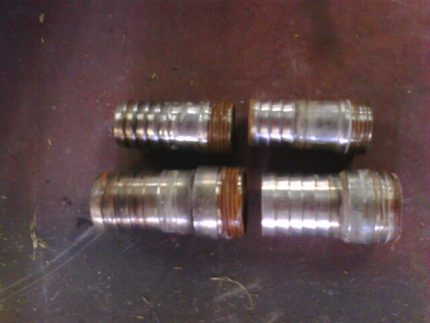
Thus, a constant acceleration of the flow will be ensured. Pumping equipment will need less energy to transport water to the surface. As a result, its effectiveness will increase, as will the depth with which water can be taken.
Part of the water produced in this way is again sent to the ejector through the recirculation pipe, and the rest goes to the water supply system of the house. The presence of an ejector has another plus. It absorbs water independently, which additionally insures the pump from idling, i.e. from a “dry running” situation, which is dangerous for all surface pumps.
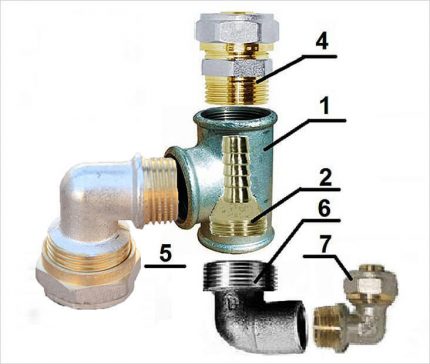
To regulate the operation of the ejector, use a conventional crane. It is installed on the recirculation pipe, through which water from the pump is directed to the ejector nozzle.Using a tap, the amount of water entering the ejector can be reduced or increased, thereby reducing or increasing the rate of return flow.
Choices: built-in or external?
Depending on the installation location, remote and built-in ejectors are distinguished. There is no big difference in the design features of these devices, but the location of the ejector still affects in some way both the installation of the pumping station and its operation.
So, built-in ejectors are usually placed inside the pump housing or in close proximity to it. As a result, the ejector takes up a minimum of space, and it does not have to be installed separately, it is enough to perform the usual installation of the pump station or the pump itself.
In addition, the ejector located in the housing is reliably protected from contamination. Depression and return of water is carried out directly in the pump casing. No need to install additional filters to protect the ejector from clogging with silt particles or sand.
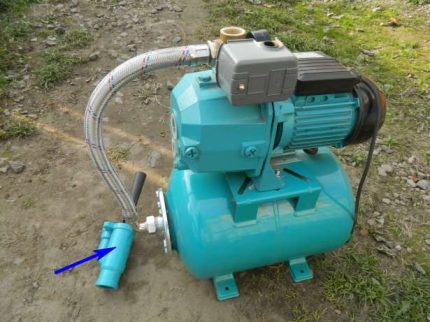
However, it should be remembered that such a model demonstrates maximum efficiency at shallow depths, up to 10 meters. Pumps with a built-in ejector are designed for such relatively shallow sources, their advantage is that they provide excellent pressure to the incoming water.
As a result of these characteristics, it is enough to use water not only for domestic needs, but also for irrigation or other business operations. Another problem is the increased noise level, since the sound effect of the water passing through the ejector is added to the vibration of the running pump.
If you decide to install a pump with a built-in ejector, you will have to take care of sound insulation especially carefully. Pumps or pumping stations with a built-in ejector are recommended to be installed outside the house, for example, in a separate building or in a well box.
The electric motor for the pump with an ejector should be more powerful than for a similar ejectorless model.
A remote or external ejector is installed at a certain distance from the pump, and this distance can be quite significant: 20-40 meters, some experts even consider the figure of 50 meters acceptable. Thus, the remote ejector can be placed directly in the water source, for example, in the well.
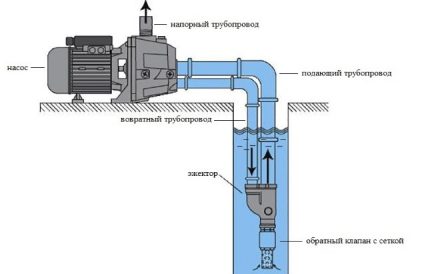
Of course, the noise from the work of the ejector, installed deep underground, will no longer bother the residents of the house. However, this type of device should be connected to the system using a recirculation pipe through which water will return to the ejector.
The greater the depth of installation of the device, the longer the pipe will have to be lowered into the well or well.
The presence of one more pipe in the well is best foreseen at the design stage of the device. The connection of a remote ejector also provides for the installation of a separate storage tank, from which water will be taken for recirculation.
This tank allows you to reduce the load on the surface pump, saving some energy. It is worth noting that the efficiency of the external ejector is slightly lower than that of the models built into the pump, however, the ability to significantly increase the depth of the fence makes us come to terms with this drawback.
When using an external ejector, there is no need to place pumping station directly near the water source. It can be installed in the basement of a residential building. The distance to the source can vary between 20-40 meters, this will not affect the performance of the pumping equipment.
Features of mounting the device
As already mentioned, the installation of an ejector built into the pump does not cause any special problems, since the device is already in the device body. The surface pump is simply connected to the water supply hose on the one hand, and also to the water supply system on the other hand.
If it is used as part of a pumping station, then the pump is connected to accumulator by means of a special fitting for five exits. In addition, the pump will need to be connected to the contacts of the pressure switch to ensure its automatic on and off.
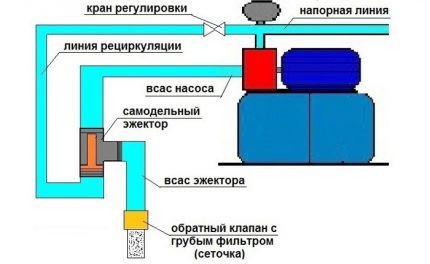
Before switching on the surface pump, it must be filled with water through the filling hole provided for this. Do not turn on such equipment without water; it can burn out. If the pump is installed correctly, the ejector will work without interruption.
But the installation of the remote ejector is made according to a more complex scheme. To begin with, it will be necessary to install a pipe that will provide a reverse flow of water from the drive to the ejector. On the suction section of the ejector set check valve. A strainer should be placed behind it to protect the device from clogging.
On top of the recirculation pipe, an adjustment valve must be installed to adjust the amount of water that is sent to the ejector. This site is not mandatory, but can significantly improve the situation with the pressure of water in the house.
The less water will return to the ejector, the more it will remain for the plumbing system at home.
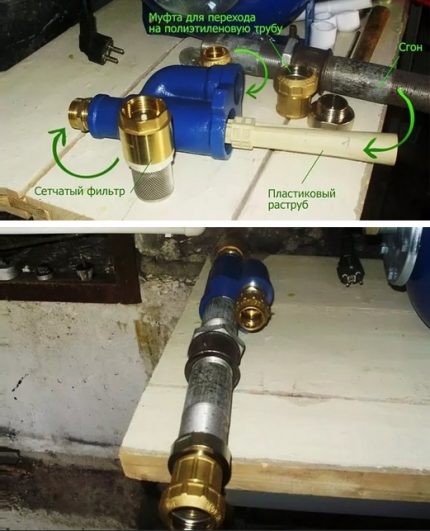
In this way, you can influence water pressure in the water supply. If it is lacking, tighten the control valve on the return line a little.
If the pressure is too large and creates an unnecessary load on the water supply system, it makes sense to send more water to the ejector to increase the efficiency of the pumping equipment.
Some industrial models of ejectors are already equipped with a system of such adjustment. The instructions that come with the device usually describe in detail how to set up the ejector.
Using a homemade external option
The built-in ejector is usually purchased simultaneously with the pump, but the external model is often made with your own hands.
It will be useful to consider the creation process and how to connect such a device. In order to make an ejector, you will need details such as a tee with internal threaded connections, a fitting, fittings, bends, couplings, etc.
DIY ejector assembly
Assemble the device as follows:
- Connect the bottom of the tee to the fitting so that the outlet pipe is at the top, and the fitting with a smaller diameter is inside the ejector.
- Then you need to refine the design, cutting off the narrow part of the fitting, if it protrudes from the tee.
- If the fitting is too short, it is expanded using a polymer tube.
- An adapter with an external thread is screwed onto the upper side of the tee.
- A PVC water pipe is connected to the other end of the adapter using a fitting.
- Now, to the bottom of the tee, in which a narrow fitting is already inserted, you should attach an outlet in the form of a corner.
- A pipe is connected to this branch, through which a return flow of water to the ejector will come.
- Another corner is connected to the side pipe of the tee.
- A pipe is connected to this corner with a collet clamp, water from a well, a well, etc. will be sucked through it.
The distance between the edge of the tee and the fitting should be approximately 2-3 mm.This will ensure the creation of a vacuum region with the necessary characteristics. A clamping nut is used to secure the recirculation pipe.
It turns out that two elements are simultaneously connected to the internal thread of the lower branch pipe of the tee. One of them (fitting) is inside the tee, and the second (corner) is outside. In order for both of them to fit on the same threaded connection, cut off part of the thread of the fitting.
Of course, all threaded connections must be sealed and sealed. Most often, FUM tape is used for this. Sometimes to connect the ejector to pumping station not metal-plastic pipes are used, but structures made of polyethylene.
For their installation, special crimping elements should be used, and collet clamps, which are good for metal plastic, will not work in this situation.
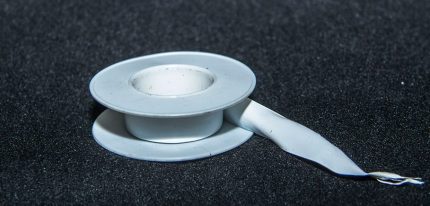
Pipe Connection Procedure
About which pipes will be used to connect a remote ejector, you should think in advance. Polyethylene structures bend well when heated, which eliminates the need for corners when connecting an ejector. The pipe is simply bent in a suitable place and at the right angle, and then attached to the ejector.
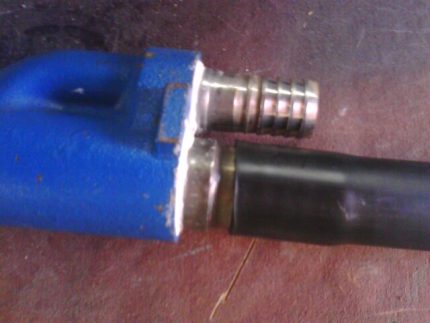
So, the device has three outputs, each of which should be connected to the corresponding pipe. First, a pipe is usually installed through which water will be drawn from the source. She joins the side exit of the ejector.
At the end of this pipe, a non-return valve, as well as a strainer, are mandatory. This pipe should be long enough to sink deep under the water. But you should not draw water at the very bottom of the source, as this can lead to clogging of the ejector, even despite the presence of a filter.
Then you can attach the pipe to the lower end of the ejector, in which a narrowed fitting is installed. This is the highway through which water is recycled. The second end of this pipe should be connected to a container from which water will be drawn to create a reverse flow.
The third pipe is an ordinary water main. At one end, it is mounted on the upper nozzle of the ejector, and the other is attached to the surface pump. It should be remembered that the diameter of the pipe through which water is drawn from the source must exceed the dimensions of the pipe through which water is supplied to the ejector.
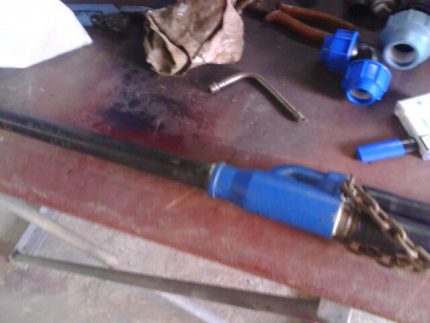
If an inch pipe is used in the feed, it is recommended to take the pipe a quarter of an inch larger for suction. After all the connections are completed, the ejector is immersed in water.
Before starting the system for the first time, it must be filled with water. The pump is poured through a special hole. Pipes leading to the ejector must also be filled with water.
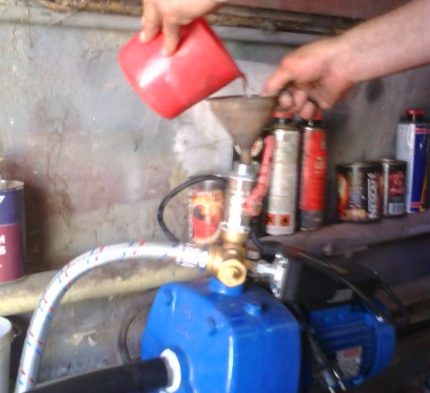
Start-up and further operation
The initial start-up of the pump station is recommended as follows:
- Pour water into the pump through a special hole.
- Turn off the tap through which water flows from the pump station to the water system.
- Turn on the pump for about 10-20 seconds and immediately turn it off.
- Open the tap and bleed part of the air from the system.
- Repeat the cycle of short on / off switching of the pump in combination with air bleeding until the pipes are filled with water.
- Switch on the pump again.
- Wait until the accumulator is full and the pump shuts off automatically.
- Open any water tap.
- Wait until the water flows out of the accumulator and the pump starts automatically.
If water did not flow when starting up the system with an ejector, it is possible that air leaks into the pipes somehow, or the initial filling with water was not performed correctly. It makes sense to check the presence and condition of the check valve. If it is not there, the water will simply pour into the well, and the pipes will remain empty.
These points should be taken into account when using a pump station with an ejector, which starts after long-term storage. Check valve, pipe integrity and tightness of the connections are best checked immediately.
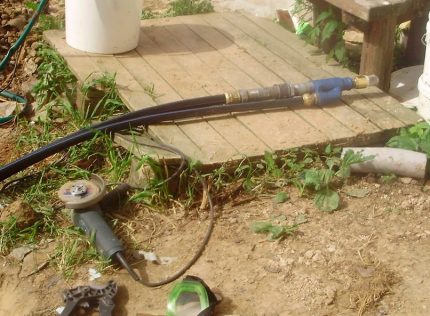
If everything is in order, and water does not enter, you need to check the voltage supplied to the pump station. If it is too low, the pump simply cannot run at full capacity. The power supply to the equipment should be normal and the problem will disappear.
If an ejector is needed to improve the pressure of the water in the system, and not to increase the depth of water intake, you can use the above-described model of a homemade ejector.
But it does not need to be immersed in water, it can be placed in a convenient place near the surface pump. In this case, the ejector will work in much the same way as the built-in model of industrial production.
Conclusions and useful video on the topic
In this video material, the issue of suction depth of a surface pump and options for solving the problem using an ejector are discussed in detail:
The principle of operation of the ejector is clearly demonstrated here:
An ejector is a simple but very useful device. This is a convenient and practical way to improve the performance of pumping equipment in a private house. But the installation of the ejector, especially the remote model, must be done correctly, the only way to ensure a noticeable increase in water pressure.
To all those interested in the issue of choosing and connecting an ejector, we suggest joining the discussions and leaving comments on the article. The comment form is below.

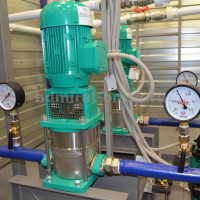 Principle of operation and design of a typical pumping station for water supply
Principle of operation and design of a typical pumping station for water supply 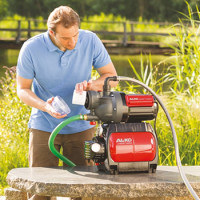 Adjustment of the pumping station: rules and algorithm for setting up the equipment
Adjustment of the pumping station: rules and algorithm for setting up the equipment 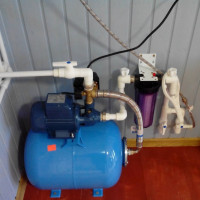 Connecting a pumping station to a well: rules for organizing autonomous water supply
Connecting a pumping station to a well: rules for organizing autonomous water supply 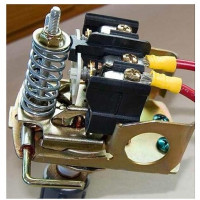 How a pressure switch for a pumping station works + rules and features of its adjustment
How a pressure switch for a pumping station works + rules and features of its adjustment 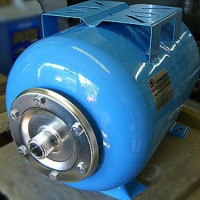 Hydraulic accumulator: device and principle of operation of a hydraulic tank in a water supply system
Hydraulic accumulator: device and principle of operation of a hydraulic tank in a water supply system 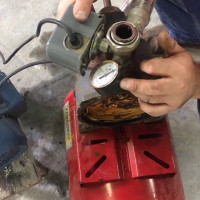 Do-it-yourself pump station repair: typical malfunctions and solutions
Do-it-yourself pump station repair: typical malfunctions and solutions  How much does it cost to connect gas to a private house: the price of organizing gas supply
How much does it cost to connect gas to a private house: the price of organizing gas supply  The best washing machines with dryer: model rating and customer tips
The best washing machines with dryer: model rating and customer tips  What is the color temperature of light and the nuances of choosing the temperature of the lamps to suit your needs
What is the color temperature of light and the nuances of choosing the temperature of the lamps to suit your needs  Replacement of a geyser in an apartment: replacement paperwork + basic norms and requirements
Replacement of a geyser in an apartment: replacement paperwork + basic norms and requirements
Hello! I have a question. There is a pump with an external ejector, bought for the occasion. Now I want to nevertheless organize a water supply system for the arrangement of the economic unit. The supply will be from the tank in 1 cubic meter. An ejector is not needed in this case. Is it possible to use a pump without an ejector and how to connect in this case?
Hello. As I understand it, you want to remove an external ejector, because for your type of water supply it really will not be needed. You write that water will be taken from a storage tank of 1 cubic meter, but how does this water get there? This is a very important question!
Will they periodically bring water to you and fill this tank or do you independently pump water into it from a well? That is, the tank is used as a hydraulic accumulator or is it the main source of water? There are no special tips for connecting the pump for the latter option. It all depends on the total consumption and the plumbing sold, calculated on the spot after the fact.
An ejector, or hydraulic elevator, is essentially a pump whose principle of operation is based on Bernoulli's law. Its device is simple: a nozzle is coaxially installed inside the pipe, a pipe with a smaller diameter, into which water is supplied through the inlet hose from the main surface pump. Due to the pressure difference, “outboard” water is sucked in and supplied under pressure through a discharge hose to the surface pump. Here, the rule must be observed: the diameter of the discharge hose is 20% larger than the diameter of the supply hose (supplied water plus suction). When using an ejector in tandem with a surface pump, the depth of water intake increases to 25 m.
Menstrual montuvati water podєm up to 40 meters of clay.
Hello Nikolai! Please help, tell me, my head is spinning from sites and information.
One fine day, the Agidel pump stopped supplying water. Redid the check valve on the flange (we have the Abyssinian well, depth 12-12.30). Redid the rubber on the piston in a glass. Glands changed - silence.
I looked out on YouTube for advice - they lowered the PND with the obat valve at the end. Agidel is dead ... they bought a Whirlwind pump - he took the water right away, but he pumped 3 cubes for 2 and a half hours, instead of the declared 70 liters per minute. I have no idea what it is. Today I again tried to install Agidel - it does not work.
Our city is small, and all our earnings are casing wells. I am an opponent of these structures. Tell me what to do? Maybe another check valve in front of Hagel? Thank!
Hello. Do not panic, you have only problems with the pump, judging by the description with the well, there are no problems, this is already good. You need to seriously approach the choice of a pump that will be involved in your water supply system from the Abyssinian well.
So, I realized that you used a surface pump, but Agidel is far from the best solution, it is very difficult and often impossible to resurrect them after a breakdown. This is me about modern options that marketers praise as a quality of the times of the USSR.
Plus, you must understand that surface pumps are not designed for high performance. Therefore, I recommend that you consider a submersible pump of exactly the screw (vortex / screw) type, since it is mounted in pipes of even the smallest diameter and can pump water with a density of sand inclusions up to 2 kg / m3.
As for the performance that you need, I do not know, but I can recommend the Belamos 3SP 90 / 1.8 borehole screw pump as equipment with the optimal price / quality ratio.
Hello. I have a specific question. I want to use an ejector in production to take a sample of water from a well. There is air pressure of 8 kg. The depth of the well is about 5 m. At the bottom there is an ejector with water of the required pressure in the water. The output is water that rises air. How to increase the power of the ejector for lifting water by 5m with air? If at all possible.
And if you connect the pipe from the ejector directly to the pump outlet?